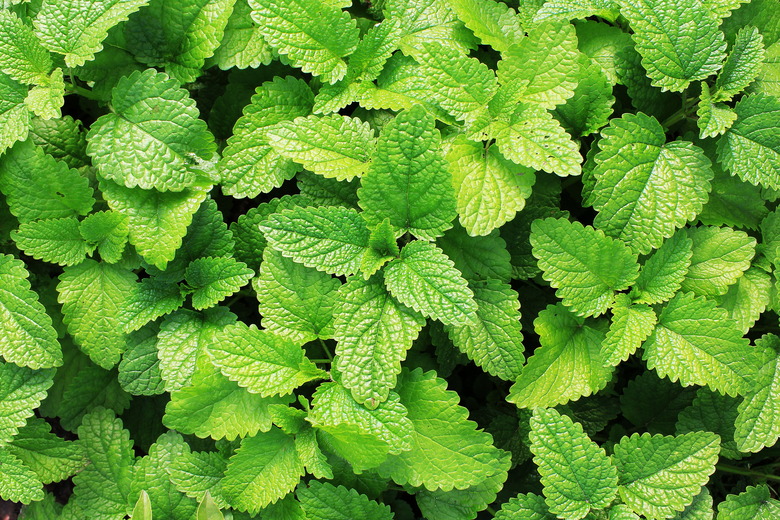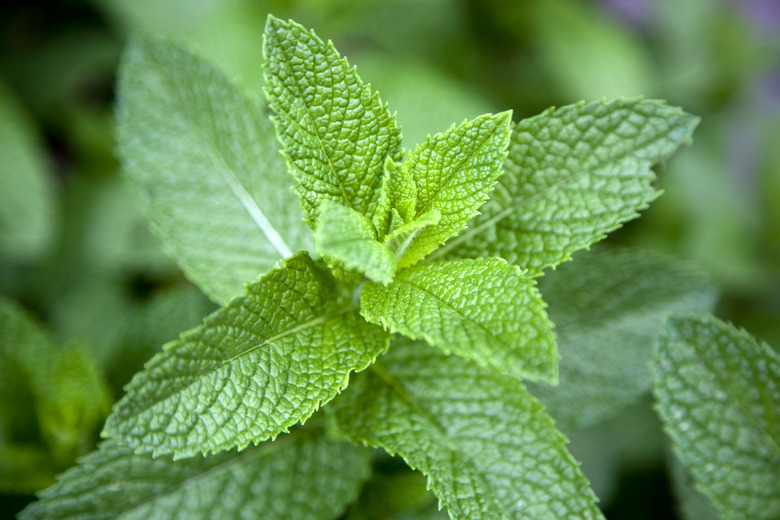How To Grow Mint
Mint (Mentha spp.) is a perennial herb with fragrant leaves suited to a wide number of culinary, hygienic, and medicinal uses. While mint leaves can be smooth, crinkled, or fuzzy and can come in varying shades of green, the plant is easily distinguished by its serrated leaves that grow on stalks 12 to 36 inches tall as well as its pretty, tiny flowers of purple, blue, pink and white that bloom in mid to late summer. These moderately frost-tolerant and drought-tolerant plants are notably easy to grow, even for the most novice gardeners. In fact, mint is so easy to grow that care needs to be taken to prevent the plant from becoming invasive and taking over its surroundings.
Best Uses for Mint
Mint is best known for its breath-freshening properties, which is why mint oil is still used in 45 percent of all toothpastes, mouthwashes, and other oral hygiene products even with so many artificial flavors on the market. It has also been used for a wide array of medicinal purposes since antiquity, and modern research shows that it can soothe a number of conditions, including irritable bowel syndrome, sore throat, indigestion, allergies, headache, anxiety, and breastfeeding pain.
While more research is required to determine its effectiveness with other conditions, it's also possible that mint can help relieve symptoms of asthma and the common cold, and it may also help improve brain function, concentration, and alertness. Mint leaves are also advantageous to health since they are surprisingly high in antioxidants, iron, vitamin A, manganese, and folate.
The attractive smell and lovely flowers of the mint plant also make it a great option for attracting bees, butterflies, and other pollinators to your garden. As a ground cover, it isn't just an unexpectedly lovely choice — it also releases a delicious smell whenever it is stepped upon. As a final bonus, many pests are actually irritated and repelled by the scent including ants, squirrels, cockroaches, mice, spiders, and deer, making it a great companion plant for any plants commonly targeted by these pests.
Of course, the main reason people grow mint is for culinary purposes. Mint grows around the globe, and it has become a popular addition to foods from around the world, including hot and cold drinks, yogurts, fruit salads, ice creams, candies, baked goods, meat rubs, vegetable salads, grain dishes, cooked vegetables, soups, and cheeses.
Types of Mint
While the most common variety of fresh mint sold in grocery stores is spearmint, there are as many as 20 different species of mint and numerous cultivars within each species. This means those who want to grow mint should spend some time researching the right variety for their needs.
The two most popular mints are spearmint (Mentha spicata, USDA zones 5-9) and peppermint (Mentha x piperita, zones 5-9). Because peppermint has far more menthol (the chemical that makes your mouth feel cold), it is generally preferred for cocktails and sweets, whereas spearmint has a less intense flavor and is better for savory dishes. Other popular varieties include chocolate mint (Mentha piperita), which has a slightly chocolate flavor, orange mint (Mentha aquatica var. citrata), which has a strong citrus flavor, and variegated pineapple mint (Mentha suaveolens 'Variegata'), which has a lighter citrus flavor.
Keeping Mint from Spreading
Before planting mint, you need to put some thought into where to grow it because it spreads easily and can quickly overtake a garden. Growing mint in above-ground pots is a good solution, but alternatively, you can also sink containers into the ground, leaving about 2 inches above the surface, or you can use plastic or metal edging sunk 8 inches deep to contain the plant. Of course, if you have an area where you don't mind mint spreading everywhere, no special precautions need to be taken.
Starting Mint From a Seedling
Mint is best started from seedlings purchased from a nursery or when propagated from a friend's plant. This is because mint seeds do not germinate well and because different types of mint crossbreed particularly easily, which results in seeds that produce offspring that taste and look different from the parent plants.
To grow mint in containers, use pots that are 8 to 24 inches wide. Create a custom soil with 1/3 high-quality potting soil, 1/3 compost, and 1/3 landscaping sand.
To plant directly in the garden, incorporate aged compost with the existing soil to improve drainage. Plant one to two seedlings in holes 6 inches deep, spaced 12 to 24 inches apart. You don't need more than a few plants since they will quickly spread. Mulch around the plants with a 2-inch layer of straw to keep in moisture and prevent weed growth. Every few months, top-dress your plants with a thin layer of compost or organic fertilizer. In spring, use a 10-10-10 fertilizer to boost new growth.
For plants grown in pots, turn the containers every two to four weeks to prevent roots from growing outside the drainage holes and into the ground. For best results in containers, mint should be divided every three to four years to help rejuvenate the plants.
In What Zone Does Mint Grow Best?
Mint grows naturally throughout the world and is very adaptable, meaning different species can be grown as annuals in USDA zones 3 through 11 or as perennials in zones 5 through 9, depending on species and cultivar. In warmer areas, be sure to mulch well and keep the soil moist. You may also need to shelter the plants from direct sun in the afternoons.
In cooler areas, mint is mildly frost-tolerant, but the foliage will die back in winter. When this happens, adding a 2-inch layer of mulch can help protect the roots, allowing the plant to grow back the following spring. If your plants are in outdoor pots, you may want to bring them into a protected indoor area before the first frost hits.
If you live somewhere outside mint's winter hardiness range, you can always grow it indoors. It prefers temperatures between 65 and 70 degrees Fahrenheit in the day and 55 to 60 degrees at night. Protect the plants from cold drafts, ensure the soil stays moist, and provide ample natural light.
When Should You Plant Mint?
In most areas, you'll want to plant mint outside in spring after the last frost has passed. If you live in a frost-free area, you can also plant in early autumn when the evening temperatures start to drop. Since root division is best done in fall or early spring, these time frames allow sufficient time for the cuttings to develop in pots before they are moved outside.
Caring for Mint
Mint prefers a light, well-draining soil with plenty of organic material. For best results, mix compost into your native soil or standard potting mix to improve drainage and add nutrients. Ideally, the soil should be pH neutral, but mint can survive in both mildly acidic and mildly alkaline soil between 5.6 and 7.5 pH.
In cooler areas, mint prefers full sun, but it's also fine with partial sun. In hotter areas, it's actually preferable to grow it in an area where it will have shade from the afternoon summer sun. Variegated varieties often prefer being out of direct sunlight, which may bleach the color from the leaves.
Mint loves water, but it doesn't want to be waterlogged. Allow the soil to become dry between waterings and then soak well. Fully established mint can be mildly drought tolerant, though it's better to keep it watered if possible. Help the soil retain moisture and prevent weed growth by adding a 2-inch layer of mulch around the plants.
How to Propagate Mint
Mint can be propagated by both root division and stem cutting. For root division, you'll want to work in the fall or early spring. Gently dig up a plant and its entire root ball and then use garden shears to divide the roots into quarters. Replant two of these quarters in the original growing area with a little space between them. Then, further divide the other two cuttings into smaller segments, each with at least one stem.
Pinch off the tops of these small segments to force the plants to focus on root growth and then plant in pots filled with appropriately amended soil. Allow the plants to grow and regain strength by setting the pots in a window or other indoor area with ample indirect light for a month before planting in their permanent containers or in the ground.
To propagate via cuttings, you can either place the stems directly in soil or in water. Simply take a 6-inch-long cutting from a stem that has healthy, fresh leaves and remove the bottom three or four sets of leaves. Next, place it directly in properly amended soil that you keep moist and wait for the plant to take off in a month or so. Alternatively, you may place the stem in a glass of water on a windowsill. Roots should form in about two weeks, and in another three weeks, the plant will be ready to be planted in soil.
How to Harvest Mint
It is easy to harvest mint, and doing so will keep your plant healthy and maintain the best-possible aroma and flavor in the leaves. You can harvest throughout the growing season, which could even be all year long in some areas, particularly if you are growing the plants indoors.
Trim off small sprigs as needed to ensure you always have fresh mint, but if you plan to dry or freeze the leaves, wait until just before the flowers bloom because this is when the flavor is most intense. When harvesting in this manner, cut the entire plant down to where there are only two sets of leaves left, which will promote bushier growth. You may be able to do this as many as three times a season. Leave around 1/3 of the plants to flower in order to attract pollinators to your garden.
Common Pests and Other Problems for Mint
While mint is a hearty plant that is more likely to repel pests than to be infested by them, it is still targeted by aphids and spider mites. Aphids appear as white spots on plants, while spider mites leave a distinctive webbing along the leaves. Both pests can be removed with a strong spray of water from a garden hose or with the use of insecticidal soap.
Common Diseases for Mint
Though mint is relatively healthy, it tends to enjoy a moist environment, which makes it susceptible to a number of fungal diseases, with the most common being anthracnose, powdery mildew, and mint rust. Anthracnose is identified by small yellowing spots on leaves that will get bigger and bigger until the leaves fall off. Mint rust can be recognized by brown or orange pustules on the bottom of the leaves. Powdery mildew will leave the stems and leaves coated in fuzzy, white dust.
The best way to prevent all of these diseases is to thin plants as needed to increase air circulation, remove dead plant debris as soon as you notice it, and avoid overwatering. If you notice a fungal infection, remove and destroy any affected plants. A sulfur fungicide can treat the problem in the soil and protect nearby plants but be sure to use it according to manufacturer instructions.

